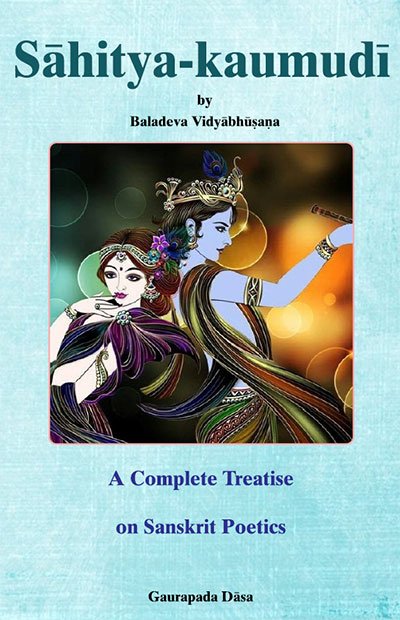Sahitya-kaumudi by Baladeva Vidyabhushana
by Gaurapada Dāsa | 2015 | 234,703 words
Baladeva Vidyabhusana’s Sahitya-kaumudi covers all aspects of poetical theory except the topic of dramaturgy. All the definitions of poetical concepts are taken from Mammata’s Kavya-prakasha, the most authoritative work on Sanskrit poetical rhetoric. Baladeva Vidyabhushana added the eleventh chapter, where he expounds additional ornaments from Visv...
Text 10.51
निरङ्गं तु शुद्धम् ॥ १०.९४च्द्१ ॥
niraṅgaṃ tu śuddham || 10.94cd1 ||
However, the niraṅga rūpaka (one metaphor without additional aspects) is single.
yathā, mukhendus tava govinda prakāśayati me manaḥ.
This is an example: O Govinda, the moon of Your face shines in my mind.
Commentary:
The niraṅga rūpaka is a fancy name for the basic type of metaphor. Mammaṭa gives this example of niraṅga rūpaka: pravṛtto’syāḥ sektuṃ hṛdi manasijaḥ prema-latikām, “Cupid has begun to water the creeper of love in her heart” (Kāvya-prakāśa, verse 423).
This verse by Paṇḍita-rāja Jagannātha illustrates rūpaka,
viśāla-viṣayāṭavī-valaya-lagna-dāvānala-prasṛtvara-śikhāvalī-vikalitaṃ madīyaṃ manaḥ |
amanda-milad-indire nikhila-mādhurī-mandire mukunda-mukha-candire ciram idaṃ cakorāyatām ||“May my mind, distressed by a series of flames emanating from the conflagration in the huge forest of sensory pleasures, act like a cakora bird toward Mukunda’s moon face: It has profuse resplendence and is the abode of all sweetness” (Karuṇā-laharī 59) (Bhāminī-vilāsa 4.1).
